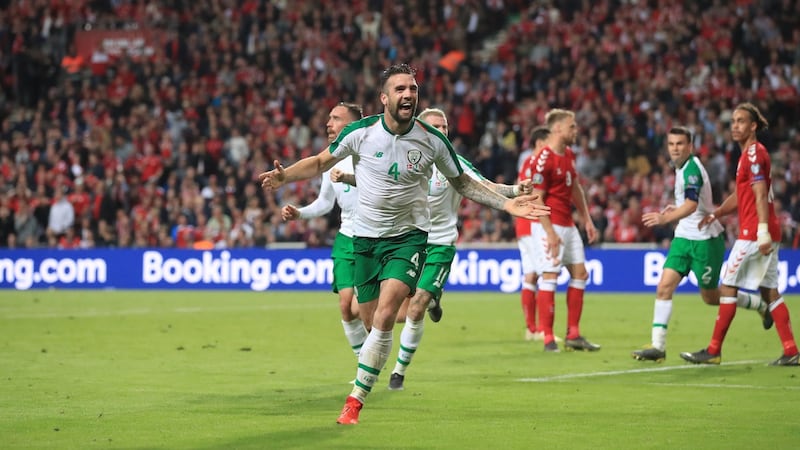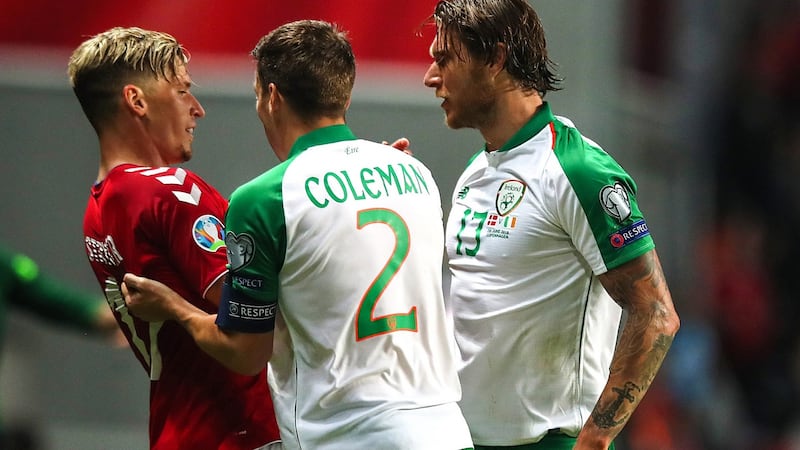When the substitute Pierre-Emile Hojbjerg headed the home side into the lead with 15 minutes to go it looked as though Denmark were headed for a deserved win. The shot count at that point was 18 attempts to three, and four on target to one.
Yet strangely, it didn’t feel quite as lopsided a contest as those figures suggest. Yes, Denmark created and missed some good chances, with the best ones for Yussuf Poulsen and Christian Eriksen denied by Darren Randolph and Shane Duffy, but they were also so frustrated by how the match had been going that three minutes before their goal, Lasse Schöne had tried a ludicrous shot from 40 yards. It was a clear sign of desperation, and his manager took him off almost immediately.
It had been a hard night’s work for Denmark. Where the last two matches Ireland had played out here had been slow and cagey, this was fast and furious, though if there was a pattern to what was happening it was mostly too subtle to be discernible to the human eye. Denmark dominated possession but it was an uncomfortable sort of domination that involved absorbing a lot of bruising tackles.
Last week, the Champions League finalists Liverpool and Tottenham seemed enervated by the three weeks’ break they’d had leading into the game. Maybe the high-speed combination play those sides produce at their best needs regular matches to stay in rhythm.

Ireland play a more basic kind of game and they seemed invigorated by their own multi-week break. They chased after Denmark with a lot of energy, but lacked the finesse to take advantage of any of the chances created by the mistakes they forced from their opponents.
In one typical flurry, Thomas Delaney’s pass across midfield was intercepted by Robbie Brady with most of the Danish players caught ahead of the ball. A great chance for the counter-attack – but Brady’s attempt at a quick pass was blocked. No matter, the ball broke for Séamus Coleman, still a promising situation for Ireland – but his attempt at a quick pass was also blocked.
Ireland did not manage to create much from their own spells of possession. Denmark played a diamond formation in midfield and the usual disadvantage of the diamond is that it allows space down the wings. However, the three more defensive Danish midfielders shuttled efficiently from side to side, blocking the easy passes. Ireland might have tried to switch play more often than they did, but instead they chipped a lot of hopeful straight balls that proved easy to cut out.
Around the hour mark came a little snapshot of why Ireland are finding it increasingly difficult to get big results at international level. Randolph had the ball, Glenn Whelan was standing 10 yards outside the box in the middle, with Duffy and Richard Keogh stationed wide of the penalty area. As Randolph deliberated over which option to choose, Whelan suddenly gestured to the goalkeeper to knock it long, turned, and charged up the field. Randolph booted it into Denmark’s half, where a Dane won the header, sending it looping back over the advancing Whelan into the enormous space he had left behind him. Poulsen runs on to it and into the Irish box for what looks a certain goal – until a last ditch sliding block from Conor Hourihane deflects his shot narrowly wide.
The previous night Frenkie de Jong had given an exhibition of the state of the art of deep-lying midfield play, as the Netherlands dismantled England in the Nations League semi-finals. Clearly, Ireland are one of the 200 or so countries that don’t have a midfielder as composed and classy as de Jong – who made our one-time great hope for the base of our midfield, Declan Rice, look ordinary. Still, it seemed paradoxical and frustrating that Ireland could resort so enthusiastically to the long ball, and still immediately expose themselves to a lethal counter-attack.
But if we allow for the usual technical shortcomings, if we have the serenity to accept the things we cannot change, at least in a short space of time, there were also some encouraging things in the Ireland performance.
If the attitude of the team during 2017 and 2018 was generally dazed and confused, subdued and forlorn, this was at least determined and competitive. When the Denmark left-back Jens Stryger-Larsen shoved Jeff Hendrick in the back, then kicked the ball against him as he lay on the ground, Coleman was immediately in to push Stryger-Larsen out of the way and stand up for his team-mate.

The incident happened just in front of the Ireland fans, who roared their encouragement: moments like these might not amount to anything tangible on the scoresheet, but emotionally they can help to change the balance of a match.
Ireland kept chasing, kept running; Denmark, who had hoped to play it out, were never comfortable. And in the end the effort was rewarded. In the circumstances, after all those grim matches and worse performances against Denmark, a one-all draw feels a thousand times better than nil-all would have. And the manner of the goal should breed a certain confidence. Ireland know that if they can get the delivery right, there are not many defenders who can stop Duffy in the air.













